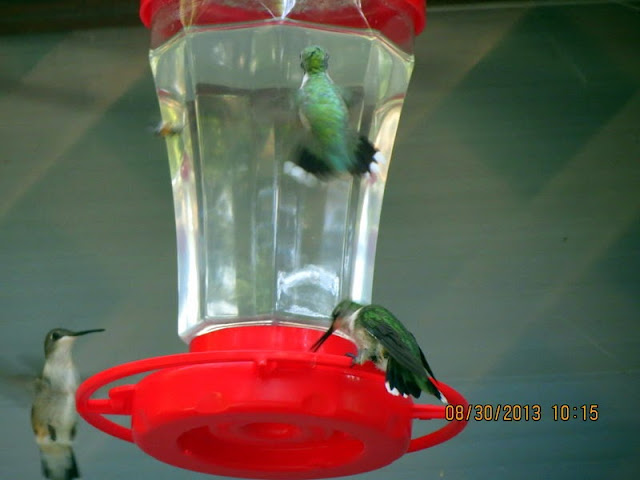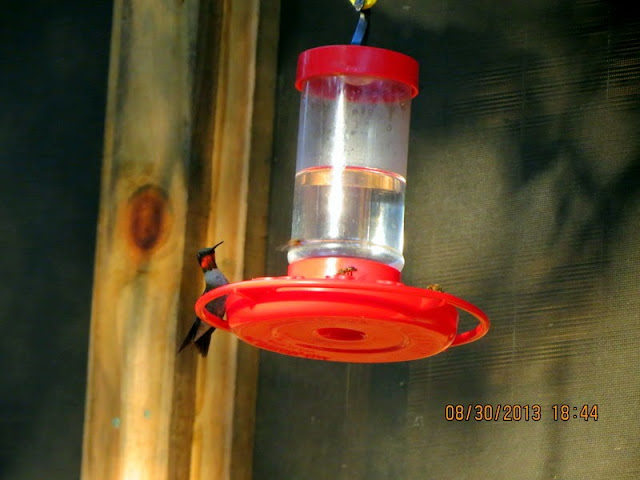Hi Everybody!!
How Hot was Hot August? Of course, it depends on your location. In my corner of Texas, it was hotter than last year (the hottest on record). I found a link to share with You (below) from the U S Drought Monitor. You can check your location on the Map and go to site for more info. (This was top search result in Google Index). Predictions for Fall in my area are continued severe drought. If anybody has an extra rain cloud, please forward immediately! Your photostudy tonight is shots of more hummers coming in. More bees are coming in also. They are stinging the birds and they got a squirrel too. So far, I have not been stung but they are just everywhere. They crawl on me and follow me around. Needless to say, I have no visitors to see the birds (due to bees). Not to worry: Sharing with You on this Blog, You will not get stung!!!! Enjoy!
Current U.S. Drought Monitor
| The data cutoff for Drought Monitor maps is Tuesday at 7 a.m. Eastern Standard Time. The maps, which are based on analysis of the data, are released each Thursday at 8:30 a.m. Eastern Time. NOTE: To view regional drought conditions, click on map below. State maps can be accessed from regional maps. |

The U.S. Drought Monitor is produced in partnership between the National Drought Mitigation Center at the University of Nebraska-Lincoln, the United States Department of Agriculture, and the National Oceanic and Atmospheric Administration.
Please visit site for updates:
LINK:
| National Drought Summary -- August 27, 2013 |
| The discussion in the Looking Ahead section is simply a description of what the official national guidance from the National Weather Service (NWS) National Centers for Environmental Prediction is depicting for current areas of dryness and drought. The NWS forecast products utilized include the HPC 5-day QPF and 5-day Mean Temperature progs, the 6-10 Day Outlooks of Temperature and Precipitation Probability, and the 8-14 Day Outlooks of Temperature and Precipitation Probability, valid as of late Wednesday afternoon of the USDM release week. The NWS forecast web page used for this section is: http://www.cpc.ncep.noaa.gov/products/forecasts/. Past Week: Several cold fronts stalled across the Southeast during the past week, bringing slightly cooler temperatures and occasional precipitation to parts of the area. Moisture from what was briefly Tropical Storm Ivo off the coast of Baja California surged into the Southwest, resulting in moderate rains (0.5 – 1.5 inches, locally heavier) over a significant portion of the region. In the central part of the Nation, above-normal temperatures combined with rapidly worsening drought, resulting in widespread deterioration of conditions especially across the Midwest. The Northeast: Most areas remain free of drought at this time. However, precipitation deficits (2-4 inches indicated on AHPS) have accumulated over north-central Pennsylvania during the past 90-days. Therefore a small area of abnormal dryness (D0) was introduced on the depiction. The Midwest: Above-normal temperatures and rapidly deteriorating soil moisture conditions have resulted in what appears to be a late-season flash drought. The CPC station temperature analysis for the past week shows a broad area of positive temperature anomalies across this region, for both maximum and minimum temperature. Maximum departures range from +4 degrees F above normal from northern Missouri to lower Michigan, to 8-11 degrees F above normal across Minnesota and adjacent portions of North Dakota and Wisconsin. NLDAS ensemble mean soil moisture output (dated August 23rd) reveals soil moisture anomalies within the root zone (top 1-meter) at 2-3 inches (locally greater) in southern parts of Minnesota, western Iowa, and northwestern Missouri. Due to the rapid onset of excessive heat combined with deteriorating soil moisture conditions, there has not yet been a significant, widespread impact on regional waterways. According to the USGS, approximately three-quarters of Midwestern stream flows are close to normal for this time of year, with most of the remainder registering as below-normal. Many areas are contending with significant impacts to crops such as corn and soybeans, while other areas appear to be less impacted, depicting considerable variation in crop conditions across the Midwest. Widespread one-category degradations were rendered accordingly to the drought depiction. As a result, a redrawing and consolidation of the short-term (S) Impact lines was necessary. Burlington, Iowa (in the southeast corner of the state) in 2013 had its wettest spring on record since 1898, with 19.23 inches of precipitation (+7.83 inches above normal). Burlington is now on track to experience its driest summer on record since 1898, with only 3.86 inches of precipitation so far (-8.41 inches below normal). Portions of the Midwest are also on track for having one of the driest Augusts on record. The Lower Mississippi Valley: Percent of Normal Precipitation (PNP) for the past 60-days ranges from 25-50 percent of normal across southern Arkansas, western Louisiana, and west-central Mississippi. Approximately one-half of the USGS stream flow gauges in western Louisiana indicate stream flow values in the lowest ten percent of the historical distribution for this day of the year. Rivers and streams in Arkansas and Mississippi appear to be faring much better, with stream flow values close to normal. Based on these considerations, one-category downgrades were made to the drought depiction in southern Arkansas, western Louisiana, and portions of western and central Mississippi. Recent rainfall over eastern Louisiana helped to erase the abnormal dryness (D0) there. Northern and Central Great Plains: As with the Midwest, the central and eastern portions of both the Dakotas and Nebraska are also experiencing problems with both excessive heat and drought. Temperatures have reached well into the 90s for many areas. Bismarck, ND, for example, topped out at 102 degrees F on August 20th. This breaks the old record of 100 degrees F set in 1976. PNP values for the past 60-days fell between the 10th and 25th percentiles across parts of eastern North Dakota and adjacent parts of Minnesota. PNP values between the 25th and 50th percentiles were common over much of the eastern Dakotas and portions of southeastern Nebraska (between Omaha and Lincoln). Based on factors such as these, widespread one-category downgrades were deemed necessary in this region. Conversely, good rains in August and decent stream flows in extreme southeastern South Dakota have resulted in much better crop conditions than the rest of the region in general. Moderate drought (D1) was improved to abnormal dryness (D0) in southern Clay and southern Union counties. Elsewhere in eastern South Dakota, Aberdeen may end up having its second driest August on record. So far this month, only 0.15-inch has fallen. The record of 0.06-inch was set back in 1947. Normal rainfall for August in Aberdeen is 2.43 inches. Southern Great Plains: Slightly above-normal temperatures, near to below-normal stream flows, and PNPs between the 25th and 75th percentiles warranted an expansion of abnormal dryness (D0) in southern Oklahoma. In Texas, lots of minor alterations were made to the drought depiction, both improvements and degradations. The West: Several relatively small changes (improvements) were made to the drought depiction across southern Wyoming, and both north-central and eastern Colorado. In northwestern Arizona, the area of extreme drought (D3) in Coconino county was reduced in size, while severe drought (D2) improved to moderate drought (D1) over much of north-central Arizona. These improvements were primarily based on several flood reports, given that rainfall data is sparse throughout this region. Hawaii, Alaska and Puerto Rico: In Hawaii, leeward portions of both Oahu and Kauai continue to experience dry conditions, prompting an expansion of abnormal dryness (D0) across southern and central portions of both Islands, as well as the introduction of moderate drought (D1) over far southern parts of these Islands. No changes were rendered to the depiction for Alaska or Puerto Rico this week. Looking Ahead: During the August 29-September 2, 2013 time period, 1.0-2.5 inches of rain is expected from western North Dakota eastward across central Minnesota, continuing southeastward across much of Wisconsin and lower Michigan. Between 1.0-1.5 inches of rain is predicted to fall across much of Arizona. Temperatures across the Midwest are forecast to be about 8-12 degrees above normal for the first half of this period, followed by a brief respite, with temperatures near seasonal values. For the ensuing 5 days (September 3-7, 2013), near to below-median rainfall is favored across most of the central third of the country. Above-median rainfall is favored across the Four Corners region, most of the Rockies and Northwest, and the northern High Plains. Near to above-normal temperatures are predicted for all but northeastern portions of the country. Author: Anthony Artusa, NOAA/NWS/NCEP/CPC |
Hello Elisabeth!
They got her eye.
The red queen has the worst sting and Nobody messes with her!
They got this juvenile
They got Elisabeth in the side.
They have not got Elvis yet.
I hope You can see how beautiful Elvis appears with his rubies!
...this is brendasue signing off from Rainbow Creek. See You next time! Dance right on in to Fall!!!!! If You know anyone who lost a few thousand bees, tell them to come get them from my Bird Sanctuary!
O+O



































































